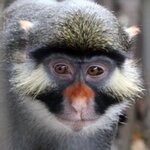Evolution

Old World monkeys have undergone a remarkable evolution in facial appearance as a way of avoiding interbreeding with closely related and geographically proximate species, according to a new paper which provides best evidence to-date for the role of visual cues as a barrier to breeding across species.
The researchers studied guenons—a group of more than two dozen species of monkeys indigenous to the forests of Central and West Africa. Many different species of guenons are often sympatric—they live in close proximity to each other, with multiple species often traveling, feeding, and sleeping…

An electric discharge experiment simulates early Earth conditions using relatively simple starting materials. The reaction is ignited by a spark, simulating lightning, which was likely very common on the early Earth.
The 1958 reaction samples were analyzed by Parker and his current mentor, Facundo M. Fernández, a professor in the School of Chemistry and Biochemistry at Georgia Tech. They conducted liquid chromatography- and mass spectrometry-based analyses and found that the reaction samples from 1958 contained peptides. Scientists from NASA's Johnson Space Center and Goddard Space Flight…

Writing about the weird soft-bodied fossils found in the Burgess Shale in the Canadian Rockies, paleontologist Stephen Jay Gould noted that of 25 initial body plans exhibited by the fossils, all but four were quickly eliminated.
If we rewound the tape, he asked, and cast the dice once more, would the same four body plans be selected? He thought it unlikely.
Obviously, we can't repeat the Burgess Shale, but Ken Olsen, an associate professor of biology at Washington University in St. Louis, says there are other ways to ask whether evolution is repeatable. One is to look at related species…

A research group uncovered that the development of wings in fruit flies does not progress synchronously with the organism's development. Instead, it is coordinated with the whole body only at distinct 'milestones'. This study helps explain how an organism facing environmental and physiological perturbations retains the ability to build correct functional organs and tissues in a proportional adult body.
For a growing organism it is essential to have robust developmental processes ensuring that the developing organs and tissues are formed correctly even in the face of environmental or…

During evolutionary diversification of vertebrate limbs, the number of toes in even-toed ungulates such as cattle and pigs was reduced and transformed into paired hooves. Scientists at the University of Basel have identified a gene regulatory switch that was key to evolutionary adaption of limbs in ungulates.
The fossil record shows that the first primitive even-toed ungulates had legs with five toes (=digits), just like modern mice and humans. During their evolution, the basic limb skeletal structure was significantly modified such that today's hippopotami have four toes, while the…

Fossilized fish specimens from the Canadian Rockies, known as Metaspriggina,
dates from the Cambrian period (around 505 million years ago), shows pairs of exceptionally well-preserved arches near the front of its body. The first of these pairs, closest to the head, eventually led to the evolution of jaws in vertebrates, the first time this feature has been seen so early in the fossil record.
Fish fossils from the Cambrian period are very rare and usually poorly preserved. This new discovery shows in unprecedented detail how some of the earliest vertebrates developed – the starting…

On the island of Java, in Indonesia, the silvery gibbon, an endangered primate, lives in the rainforests and engages in behavior that's unusual for a primate - it sings long, complicated songs, using 14 different note types, that signal territory and send messages to potential mates and family.
Far from being a mere curiosity, the silvery gibbon may hold clues to the development of language in humans, according to a paper which asserts that by re-examining contemporary human language, we can see indications of how human communication could have evolved from the systems underlying the older…

For the last 2.5 million years, our planet has experienced lengthy cold cycles with brief interruptions by warm ones. During cold periods, continental-scale ice sheets blanketed large tracts of the northern hemisphere and as the climate warmed up, these colossal glaciers receded, leaving Yosemite-like valleys and other majestic geologic features behind.
Obviously, the advance and retreat of the ice sheets also had a profound influence on the evolution and geographic distribution of many animals, including those that live today in the Arctic regions.
A new study published in the Proceedings…

Like with many things, a lot of variables go into evolution. Some is luck, some is necessity, some is circumstance. Over time, for example, a region of blacksmiths will grow bigger arms. It isn't an epigenetic or Lamarckian evolution event but it will happen over generations because holding a hammer becomes important in that circumstance.
Almost anything can claim an evolutionary basis, if you try hard enough. In the run up to the last American presidential election, there were even claims that people were born liberal or conservative. Yes, social psychologists and the political pundits who…

The mitochondrial DNA of the first Near Eastern farmers has been sequenced for the first time. In the research, experts analysed samples from three sites located in the birthplace of Neolithic agricultural practices: the Middle Euphrates basin and the oasis of Damascus, located in today's Syria and date at about 8,000 BC.
The study is focused on the analysis of mitochondrial DNA --a type of non-Mendelian maternally inherited DNA-- from the first Neolithic farmers, by means of samples obtained by the Universitat Autònoma de Barcelona (UAB) research group which were first processed by the…